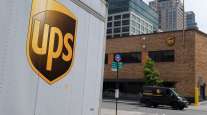Severe Winter Cuts UPS Earnings; Package Unit Hurt Most by Storms
This story appears in the April 28 print edition of Transport Topics.
UPS Inc. last week said its first-quarter net income fell 12%, as higher costs triggered by bad winter weather cut companywide profitability by $200 million.
Net income was $911 million, or 98 cents per share, as revenue rose 2.6% to $13.8 billion. Storm and cold-related damage was felt the most in the package unit, where expenses rose by $375 million, outpacing $217 million in revenue growth.
A stronger international performance that included a 24% profit increase to $438 million helped to limit the damage. Results also improved in the supply chain and freight sector, despite weather-related declines at the UPS Freight unit.
Separately, the Teamsters union said the package division contract covering more than 235,000 workers was being put into effect on April 25. Ratification of the full five-year deal with a $3.90-per-hour wage increase was delayed nine months by votes on side agreements.
Though earnings declined, UPS joined a chorus of transport companies, including motor carriers and freight railroads, whose quarterly earnings commentary has forecast that stronger results lie ahead, spurred by an improved U.S. economy.
“During the quarter, the momentum of the underlying business was masked by the disruption of inclement weather,” said Kurt Kuehn, UPS chief financial officer. “We are encouraged by the positive trends in our business and expect the remainder of the year to perform” as previously expected.
President of U.S. Operations Myron Gray expanded on that comment during a conference call, saying that “the macroeconomic environment looks decent as we move forward. Both the global GDP and U.S. GDP will be a little better than they were last year.”
“In domestic, we started seeing improvement at the end of March, and we’re seeing it in April,” Gray added.
The weather-related damage to earnings transformed a quarter that would have resulted in higher profits, UPS said.
“The company experienced lost revenue and additional cost as a result of significant network disruptions on more than half of the operating days during the quarter,” said the statement from UPS, which ranks No. 1 on Transport Topics Top 100 list of the largest for-hire carriers in the United States and Canada.
The first-quarter weather effects were expected, as one analyst labeled the performance by UPS as “no surprise” and another said it was “much ado about nothing.”
In the domestic package business, shipment volume increased 4.2%, UPS said, mostly driven by “large e-commerce shippers using lightweight deferred shipping solutions.”
Domestic package revenue increased 2.6% to $8.49 billion. Customers’ decisions to use lower-cost domestic shipping, such as second-day air, reduced revenue per package by 1.5% to $9.35.
Cost increases in the package unit included a 20% increase in overtime pay and higher purchased transportation expenses.
In the less-than-truckload business run by UPS Freight, “operating profit was lowered by increased network costs associated with the difficult conditions,” Kuehn said on a conference call.
UPS does not disclose specific profitability for the LTL unit.
Tonnage fell 1.9%, reflecting a 1.2% drop in shipments and lighter cargo weight. Revenue per 100 pounds of freight, however, improved 3.1% to $22.52.
In total, LTL revenue rose 1%, or $7 million, to $603 million. Truckload revenue at UPS Freight slipped $1 million to $91 million.
Improvements on the international package front included a 7.9% increase in daily volume and a 5% increase in revenue to $3.13 billion.
A 15% growth in the recovering European market was a key factor in the stronger international results, UPS said. Costs related to last year’s failed bid to buy Dutch logistics company TNT hurt 2013 first-quarter profit by $39 million in the international business.
Like the domestic market, revenue per international package dipped 2.1% due to lower-cost options.
In last year’s first quarter, net income was $1.04 billion, or $1.08 per share. Those results were inflated by $36 million as a result of one-time tax gains.
Overall, the supply chain and freight business raised profit, excluding taxes and interest, by 3.5% to $148 million, though revenue fell 1% to $2.16 billion. Results improved in the forwarding, ocean freight and brokerage activities, and increased retail and health care revenue boosted the distribution unit.
UPS also refined its full-year profit forecast, saying that, in light of first-quarter results, full-year earnings are expected to be “at the low end of our full-year guidance range of $5.05 to $5.30” per share.




